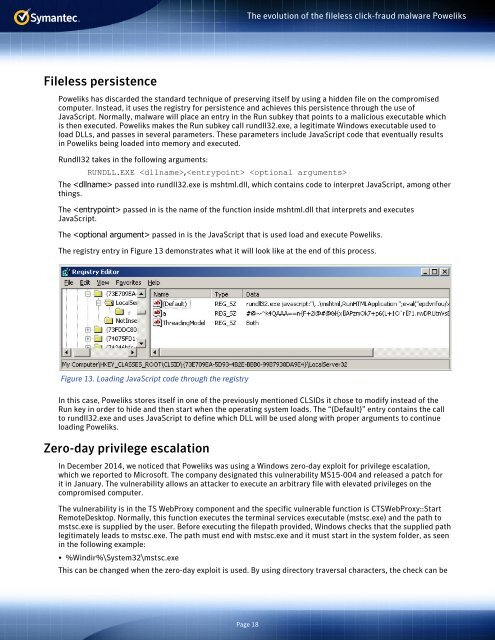evolution-of-poweliks
evolution-of-poweliks
evolution-of-poweliks
You also want an ePaper? Increase the reach of your titles
YUMPU automatically turns print PDFs into web optimized ePapers that Google loves.
The <strong>evolution</strong> <strong>of</strong> the fileless click-fraud malware Poweliks<br />
Fileless persistence<br />
Poweliks has discarded the standard technique <strong>of</strong> preserving itself by using a hidden file on the compromised<br />
computer. Instead, it uses the registry for persistence and achieves this persistence through the use <strong>of</strong><br />
JavaScript. Normally, malware will place an entry in the Run subkey that points to a malicious executable which<br />
is then executed. Poweliks makes the Run subkey call rundll32.exe, a legitimate Windows executable used to<br />
load DLLs, and passes in several parameters. These parameters include JavaScript code that eventually results<br />
in Poweliks being loaded into memory and executed.<br />
Rundll32 takes in the following arguments:<br />
RUNDLL.EXE , <br />
The passed into rundll32.exe is mshtml.dll, which contains code to interpret JavaScript, among other<br />
things.<br />
The passed in is the name <strong>of</strong> the function inside mshtml.dll that interprets and executes<br />
JavaScript.<br />
The passed in is the JavaScript that is used load and execute Poweliks.<br />
The registry entry in Figure 13 demonstrates what it will look like at the end <strong>of</strong> this process.<br />
Figure 13. Loading JavaScript code through the registry<br />
In this case, Poweliks stores itself in one <strong>of</strong> the previously mentioned CLSIDs it chose to modify instead <strong>of</strong> the<br />
Run key in order to hide and then start when the operating system loads. The “(Default)” entry contains the call<br />
to rundll32.exe and uses JavaScript to define which DLL will be used along with proper arguments to continue<br />
loading Poweliks.<br />
Zero-day privilege escalation<br />
In December 2014, we noticed that Poweliks was using a Windows zero-day exploit for privilege escalation,<br />
which we reported to Micros<strong>of</strong>t. The company designated this vulnerability MS15-004 and released a patch for<br />
it in January. The vulnerability allows an attacker to execute an arbitrary file with elevated privileges on the<br />
compromised computer.<br />
The vulnerability is in the TS WebProxy component and the specific vulnerable function is CTSWebProxy::Start<br />
RemoteDesktop. Normally, this function executes the terminal services executable (mstsc.exe) and the path to<br />
mstsc.exe is supplied by the user. Before executing the filepath provided, Windows checks that the supplied path<br />
legitimately leads to mstsc.exe. The path must end with mstsc.exe and it must start in the system folder, as seen<br />
in the following example:<br />
• %Windir%\System32\mstsc.exe<br />
This can be changed when the zero-day exploit is used. By using directory traversal characters, the check can be<br />
Page 18


